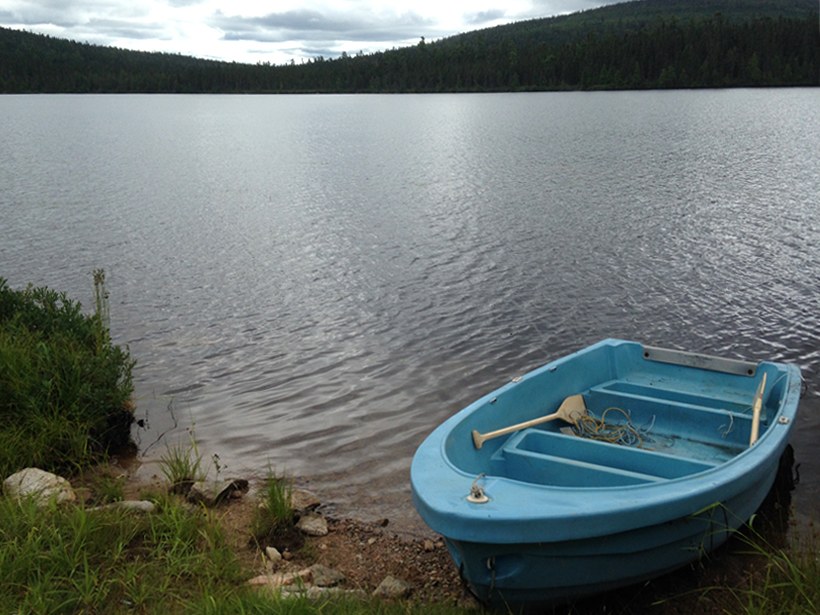After Rachel Carson’s groundbreaking book Silent Spring exposed the dangers of widespread pesticide use in 1962, many chemicals, including dichlorodiphenyltrichloroethane (DDT), were restricted or banned starting in the early 1970s. But their chemical legacy lives on: A new study has found alarmingly high levels of DDT in remote wilderness lakes in northern New Brunswick, Canada, as well as evidence that the pesticide continues to impact aquatic species and alter the lakes’ food webs more than 50 years after being banned.

From the 1950s into the 1970s, DDT was widely applied from airplanes to North American forests. DDT and other chemicals were deployed to manage insect outbreaks such as spruce budworm, the population of which naturally booms every 30 to 40 years.
Much of northern New Brunswick is managed as a commercial forest operation, and during the 1950s and 1960s, over 6 million kilograms of DDT were applied to these forests, says Josh Kurek, an environmental scientist at Mount Allison University in Sackville, New Brunswick, and lead author of the new study, published in Environmental Science and Technology. “The spray program run by the forest stakeholders in New Brunswick was arguably the largest in the world,” he says.
To see whether the ecosystem retained relics of its pesticide-soaked past, Kurek and colleagues analyzed sediment cores collected from five remote lakes in different watersheds in north central New Brunswick. They found that all five lakes had “surprisingly high” levels of DDT and its toxic breakdown products (DDTs), Kurek says. DDT’s breakdown products, including dichlorodiphenyldichloroethane (DDD) and dichlorodiphenyldichloroethylene (DDE), are also toxic to aquatic organisms and wildlife.
“The concentration of DDTs in the region’s lake sediments is some of the highest values reported in North America,” Kurek says.
“All five lakes showed similar patterns, with DDT levels well above the probable effect level (PEL) where scientific studies show it can cause harm to life-forms,” he says. Modern sediments are, on average, 16 times above PEL for DDE, typically the most abundant breakdown product of DDT.
The team also dated the sediment cores to determine a timeline for when the DDT entered the lakes. Peak DDT concentrations occurred in the mid-1970s, about 10 to 15 years after the most intense spraying took place. “The lag effect is due to the time it took for the contaminant to move from the trees to the soils and into the lakes,” Kurek says.
“We thought we were done with DDT when we banned it. But, of course, it’s still around, quietly wreaking havoc.”
“The amount of DDTs in these lakes is staggering. It’s amazing how much there is, even for those of us old enough to remember the planes flying over and dusting everything in sight,” said John Smol, a paleolimnologist at Queen’s University in Ontario, Canada, who was not involved in the new study. “We thought we were done with DDT when we banned it. But, of course, it’s still around, quietly wreaking havoc.”
DDT and Food Webs
The half-life of DDT varies because of environmental conditions but is estimated to be between decades to 100 years. DDT doesn’t dissolve in water; it tends to bind to organic materials like algae or soil particles. When the contaminated algae are eaten, the DDT bioaccumulates in the animal’s tissues. If the algae eater is then eaten by a fish or other predator, the DDT gets passed up the food web in higher and higher concentrations.
To study the impact of DDT and DDTs on lake food webs, Kurek and colleagues used their sediment cores to reconstruct the population over time of a common species of water flea called Daphnia. They found that as DDT levels increased in the lake, the population of Daphnia decreased.
When a lake is contaminated by an insecticide, it experiences “death by a thousand cuts,” Kurek says. “The effects are not acute but rather chronic, playing out over many years.”
Next, the team plans to study DDT contamination higher in the food web. “One of the key unanswered questions is whether the higher trophic levels, such as wild brook trout that people eat, are elevated in DDTs.”
For anglers, it’s possible that nowhere is safe. “I think it would be a real challenge to find a remote lake, wetland, or shallow pond that doesn’t record the past use of DDT,” Kurek says. “When we ban a chemical, we wash our hands of it and move on. But these legacy contaminants have a nasty habit of sticking around for a very long time.”
—Mary Caperton Morton (@theblondecoyote), Science Writer
Citation:
Morton, M. C. (2019), The toxic legacy of DDT lives on in remote Canadian lakes, Eos, 100, https://doi.org/10.1029/2019EO128877. Published on 23 July 2019.
Text © 2019. The authors. CC BY-NC-ND 3.0
Except where otherwise noted, images are subject to copyright. Any reuse without express permission from the copyright owner is prohibited.

